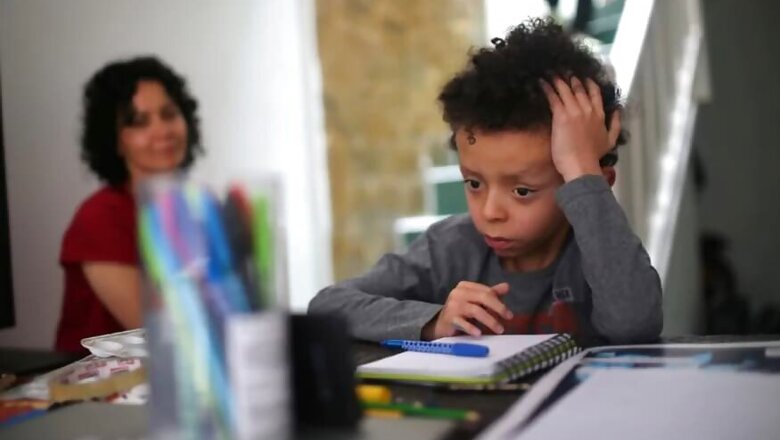
views
The COVID-19 pandemic has resulted in widespread closures of all educational institutions across the country. Considering physical schools can be unsafe in the absence of vaccinations, most of the educational institutes have come up with the solution of remote education from online platforms like Google Classroom, Zoom, etc.
These are trying times for everyone all over the world. The students are struggling to cope with this change in routine, they are not able to meet their friends and do the activities that they usually do. The teachers must familiarise themselves with new technology and digital platforms they have never used before, parents on the other hand have to manage their child’s academics and their jobs.
Pros of Online Learning
Though many people were initially skeptical about this option, online learning can be a boon if used in the right manner. We have to learn to strike a balance while providing online education to kids and expand our horizons. If used properly, the benefits of online education know no bounds.
Reduced costs: Online education can be a good cost saver as most of the reading or reference materials is quite accessible online.
Multiple learning options: Online education is highly interactive. The ways in which children can be taught virtually is limitless. For example: Children can get a better understanding of a topic being taught when teachers use virtual tools like graphics/ videos to make them understand
Builds confidence in a child: A typical Indian classroom involves about 70-80 students. It is difficult for children who are shy to raise their hands and clarify their doubts. Online classes can provide a certain level of anonymity, where the child may not be so scared of talking to the teacher from behind a computer screen. This boost of confidence will help them perform better and encourage them to participate more in the classroom activities.
Interactive session: Online classes, which are interactive in nature, would garner more attention and interest from students.
Cons of Online learning
Online learning is not without its disadvantages though, some disadvantages of online are:
Not easily accessible: In a country like ours where a large portion of the population still struggles with poverty, using technology as a method to educate children will not be easy. Many people do not have access to required devices and internet connection, especially in villages.
Less personal: Online learning reduces the personal interaction between students and teachers and this increases the communication gap between them. In addition, many a times online classes are interrupted due to technical glitches due to poor internet connection.
Difficulty in adapting: Even though many schools have announced that they will be providing online classes to students, the teachers however are just not prepared. They have to familiarize themselves with the technology; this will be difficult especially for older teachers who have never used platforms like Zoom or Microsoft teams.
Excess exposure to screen time: Online classes can lead to increased exposure to screens for children, which can affect adversely. It is however important to remember that to tackle the present situation, online learning needs to be given a chance. However, there are certain measures parents can opt to ensure kids do not overdo it.
Screen Time for Kids
Co-viewing: Co-viewing is a great option especially among younger children as they learn best when they are re-taught in the real world what they just learnt through a screen.
Make your own family media use plan and monitor the screen time: It is important to remember that children between 18-24 months should not be exposed to digital media other than occasional video chatting.Limit screen use for pre-school children, ages between 2 to 5, to just 1 hour a day of high-quality programming.
Screen time can be bonding time: When you are more personally involved in your child’s education and co-view their classes, it encourages bonding as well as learning. You can also make your child realise that online learning is not always about studies. Play a video game with your kids. It is a good way to demonstrate good sportsmanship and gaming etiquette. Watch a show with them; you will have the opportunity to introduce and share your own life experiences and perspectives, and guidance.
Engaging in back and forth ‘talk-time’: Engaging in back-and-forth "talk time" is critical for language development. Conversations can be face-to-face or, if necessary, by video chat with a traveling parent or far-away grandparents. Research has shown that it is that "back-and-forth conversation" that improves language skills—much more so than "passive" listening or one-way interaction with a screen.
Create tech-free zones in house: Keep family mealtimes, other family and social gatherings, and children's bedrooms screen free. Turn off televisions when you are not watching, because background TV noise can get in the way of face-to-face time with kids. Also, remember to recharge the devices overnight outside your child’s bedroomto help avoid the temptation to use them when they should be sleeping. These changes encourage more of family time, healthier eating habits, and better sleep.
Be a good role model: Teach and model kindness and good manners online. Because children are, great mimics and they will repeat whatever you show them. Teach the children the value of face-to-face communication.
Every form of technology comes with its boons and curses; it is the way we use determines how or how much it can influence us. It is the same case for online learning as well,if used properly it can be a blessing. Maintaining a healthy balance is imperative in order to pave a great future for kids and incorporating some of the above guidelines can certainly go a long way in making the most of online/ at-home learning.




















Comments
0 comment